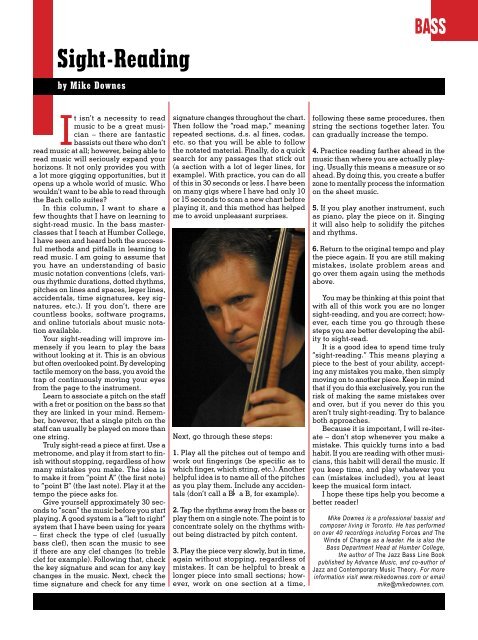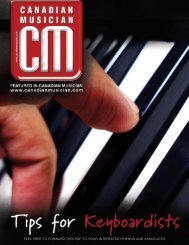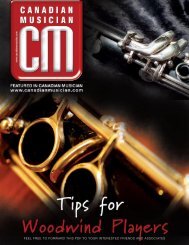Create successful ePaper yourself
Turn your PDF publications into a flip-book with our unique Google optimized e-Paper software.
Sight-Readingby Mike DownesBassIt isn’t a necessity to readmusic to be a great musician– there are fantasticbassists out there who don’tread music at all; however, being able toread music will seriously expand yourhorizons. It not only provides you witha lot more gigging opportunities, but itopens up a whole world of music. Whowouldn’t want to be able to read throughthe Bach cello suites?In this column, I want to share afew thoughts that I have on learning tosight-read music. In the bass masterclassesthat I teach at Humber College,I have seen and heard both the successfulmethods and pitfalls in learning toread music. I am going to assume thatyou have an understanding of basicmusic notation conventions (clefs, variousrhythmic durations, dotted rhythms,pitches on lines and spaces, leger lines,accidentals, time signatures, key signatures,etc.). If you don’t, there arecountless books, software programs,and online tutorials about music notationavailable.Your sight-reading will improve immenselyif you learn to play the basswithout looking at it. This is an obviousbut often overlooked point. By developingtactile memory on the bass, you avoid thetrap of continuously moving your eyesfrom the page to the instrument.Learn to associate a pitch on the staffwith a fret or position on the bass so thatthey are linked in your mind. Remember,however, that a single pitch on thestaff can usually be played on more thanone string.Truly sight-read a piece at first. Use ametronome, and play it from start to finishwithout stopping, regardless of howmany mistakes you make. The idea isto make it from “point A” (the first note)to “point B” (the last note). Play it at thetempo the piece asks for.Give yourself approximately 30 secondsto “scan” the music before you startplaying. A good system is a “left to right”system that I have been using for years– first check the type of clef (usuallybass clef), then scan the music to seeif there are any clef changes (to trebleclef for example). Following that, checkthe key signature and scan for any keychanges in the music. Next, check thetime signature and check for any timesignature changes throughout the chart.Then follow the “road map,” meaningrepeated sections, d.s. al fines, codas,etc. so that you will be able to followthe notated material. Finally, do a quicksearch for any passages that stick out(a section with a lot of leger lines, forexample). With practice, you can do allof this in 30 seconds or less. I have beenon many gigs where I have had only 10or 15 seconds to scan a new chart beforeplaying it, and this method has helpedme to avoid unpleasant surprises.Next, go through these steps:1. Play all the pitches out of tempo andwork out fingerings (be specific as towhich finger, which string, etc.). Anotherhelpful idea is to name all of the pitchesas you play them. Include any accidentals(don’t call a B a B, for example).2. Tap the rhythms away from the bass orplay them on a single note. The point is toconcentrate solely on the rhythms withoutbeing distracted by pitch content.3. Play the piece very slowly, but in time,again without stopping, regardless ofmistakes. It can be helpful to break alonger piece into small sections; however,work on one section at a time,following these same procedures, thenstring the sections together later. Youcan gradually increase the tempo.4. Practice reading farther ahead in themusic than where you are actually playing.Usually this means a measure or soahead. By doing this, you create a bufferzone to mentally process the informationon the sheet music.5. If you play another instrument, suchas piano, play the piece on it. Singingit will also help to solidify the pitchesand rhythms.6. Return to the original tempo and playthe piece again. If you are still makingmistakes, isolate problem areas andgo over them again using the methodsabove.You may be thinking at this point thatwith all of this work you are no longersight-reading, and you are correct; however,each time you go through thesesteps you are better developing the abilityto sight-read.It is a good idea to spend time truly“sight-reading.” This means playing apiece to the best of your ability, acceptingany mistakes you make, then simplymoving on to another piece. Keep in mindthat if you do this exclusively, you run therisk of making the same mistakes overand over, but if you never do this youaren’t truly sight-reading. Try to balanceboth approaches.Because it is important, I will re-iterate– don’t stop whenever you make amistake. This quickly turns into a badhabit. If you are reading with other musicians,this habit will derail the music. Ifyou keep time, and play whatever youcan (mistakes included), you at leastkeep the musical form intact.I hope these tips help you become abetter reader!Mike Downes is a professional bassist andcomposer living in Toronto. He has performedon over 40 recordings including Forces and TheWinds of Change as a leader. He is also theBass Department Head at Humber College,the author of The Jazz Bass Line Bookpublished by Advance Music, and co-author ofJazz and Contemporary Music Theory. For moreinformation visit www.mikedownes.com or emailmike@mikedownes.com.





